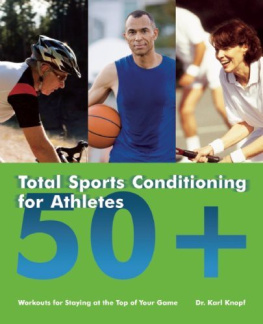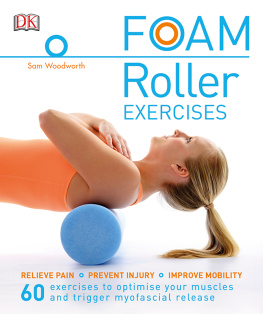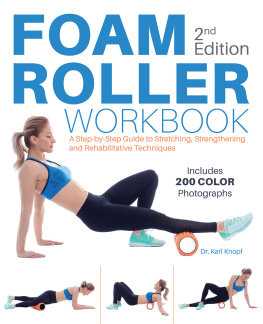
Text Copyright 2014 Karl Knopf. Design and Concept 2014 Ulysses Press and its licensors. Photographs copyright 2014 Rapt Productions. All rights reserved. Any unauthorized duplication in whole or in part or dissemination of this edition by any means (including but not limited to photocopying, electronic devices, digital versions, and the Internet) will be prosecuted to the fullest extent of the law.
Published in the United States by
Ulysses Press
P.O. Box 3440
Berkeley, CA 94703
www.ulyssespress.com
ISBN: 978-1-61243-390-5
Library of Congress Control Number 2014932311
10 9 8 7 6 5 4 3 2 1
Acquisitions: Keith Riegert
Managing editor: Claire Chun
Editor: Lily Chou
Proofreader: Lauren Harrison
Indexer: Sayre Van Young
Front cover and interior design: what!design @ whatweb.com
Cover photographs: Rapt Productions
Interior photographs: Rapt Productions except on page 9 muscle anatomy marema/shutterstock.com; page 16 man walking Viorel Sima/shutterstock.com; page 18 woman high step Anetlanda/shutterstock.com; page 20 sitting mans back Stefano Cavoretto/shutterstock.com; page 21 sitting womans back Maksim Shmeljov/shutterstock.com; page 22 mans arm and shoulder muscles Anetta/shutterstock.com; page 23 man with cell Rido/shutterstock.com; page 24 weightlifter Ljupco Smokovski/shutterstock.com; page 25 baseball player Beto Chagas/shutterstock.com; page 26 basketball player Eugene Onischenko/shutterstock.com; page 27 cyclist ostill/shutterstock.com; page 28 golfer tmcphotos/shutterstock.com; page 29 runner Ariwasabi/shutterstock.com; page 30 soccer player wavebreakmedia/shutterstock.com; page 31 swimmer Pavel Sazonov/shutterstock.com; page 32 tennis player Sveta Orlova/shutterstock.com
Models: Christopher Caruthers, Toni Silver, Nadia Velasquez
Make-up: Sabrina Foster
Distributed by Publishers Group West
Please Note
This book has been written and published strictly for informational purposes, and in no way should be used as a substitute for actual instruction with qualified professionals. The author and publisher are providing you with information in this work so that you can have the knowledge and can choose, at your own risk, to act on that knowledge. The author and publisher also urge all readers to be aware of their health status and to consult health care professionals before beginning any health program.
Contents
To the world youre only one person, but to one person you may be the world! Just like the flight attendant who tells you to put on your own oxygen mask before you help someone else, so it is with you. You cant take care of others until you take care of yourself. And you deserve it!
Today we have good research that shows that when done regularly and performed prudently, simple things such as proper exercise, relaxation and stretching can be used to prevent, alleviate or even restore our bodies to optimal levels. Foam rollers have been used in physical therapy settings for many years. Now theyre incorporated in yoga, Pilates and general fitness classes to relax and stretch tight muscles, as well as release tight spots. The foam roller can be used to prevent possible issues and as a rehabilitation tool. Foam rollers with knobs and grooves are especially geared toward releasing trigger points and muscle knots, which can contribute to pain, discomfort and reduced range of motion.
Trigger Point Therapy with the Foam Roller borrows elements from acupressure, massage, and relaxation and flexibility techniques to help you establish normal range of motion, improve flexibility, prevent possible injury and reduce your level of discomfort using the trigger point foam roller.
Dr. Mosh Feldenkrais is credited for being the first person to use foam rollers for therapeutic purposes (for instance, improving body alignment, reducing muscle tightness and teaching body awareness) in the late 1950s. The beauty of the foam roller is that it can be used by almost everyone. In a therapy setting, foam rollers have been used by clients who have multiple sclerosis as well as those with common orthopedic concerns such as lower back syndrome and rotator cuff issues.
The foam roller is lightweight, easy to use and inexpensive to purchase. It comes in various shapes, sizes and densities and can be purchased online, at sporting goods stores and at physical therapy clinics. The type of foam roller youre probably most familiar with is smooth. The one this book focuses onthe kind we call a trigger point foam rollerhas small and large knobs on it to provide a deeper massage than a smooth roller can.

The human body is designed in a remarkable manner and, if well maintained, can function very efficiently for a very long time. However, simply living, combined with chronic missteps and overuse, causes us to sometimes misuse and abuse our bodies, which often leads to poor posture, chronic pain or even disability. Fortunately, we live in a time that offers ample access to both traditional medical treatments as well as complementary options, such as massage, acupressure and biofeedback.
To achieve our fitness goals we often push and hurry. Too often we find that if we dont listen to, observe and use our intuition, nature has a way of getting our attention with an ache or a pain. Pain is our bodys warning light, but many of us just disconnect the light and forget about it.
Pain is a major complaint, contributing to about 40 percent of doctor visits. Each of us hurts and feels pain differentlyhow we treat the pain or discomfort is totally up to us. Many people find relief by using medicines and injections. Others look to complementary options. Unfortunately, sometimes even a combination of these still doesnt result in total relief of chronic discomfort. Theres no universal solutionthe solution needs to match you and your philosophy.
Understanding pain and discomfort is a complex subject, well beyond the scope of this book. In medicine, doctors can measure our blood pressure and temperature, but measuring pain is very subjective. Some doctors have patients describe their pain using a scale of 1 to 10. Others have patients circle the face that best represents their pain level, like the chart you see below.

Research has shown that stretching, relaxation, meditation, trigger point treatments and biofeedback techniques ease muscle tension that contributes to pain. Regular stretching is useful to release muscle tension and lengthen shortened muscles, decreasing pain. Massage is most peoples favorite because it can reduce anxiety that contributes to reducing muscle tension. Massage can also increase blood flow to an area, which may hasten healing.

Massage is the manipulation of superficial and deeper layers of muscle and connective tissue using various techniques. Massage is used to enhance function, aid in the healing process, decrease muscle reflex activity, inhibit motor-neuron excitability, and promote relaxation and well-being. Most experts agree on the following benefits of a massage:


Next page












